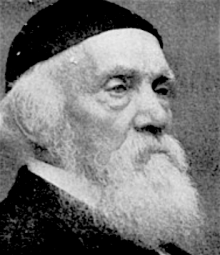
John Burnet [also known as John Burnet senior] was born in Kirk o'Shotts, Scotland on 27 September 1814. He initially trained as a carpenter, but switched to architecture, gaining experience by working as clerk of works for an architect and builder, thought to have been John Smith in Glasgow. Otherwise he received little training in the profession and was largely self-taught.
He commenced independent practice as an architect in Glasgow in 1843. Within a year he had designed three churches - Alloa Free Church, Clackmannan Free Church and Shandon Free Church, and during the first fifteen years of his practice he primarily worked on church commissions. This included Milton Free Church in Glasgow (c.1849); a Congregational Church in Glasgow (1854); Berkeley Street United Presbyterian Church in Glasgow (1855); Elgin Place Congregational Church in Glasgow (1856); Evangelical Union Congregational Church in Glasgow (1856); and Finnieston Street Free Church in Glasgow (1856). Whilst he continued to design churches, from the late 1850s onwards, his practice moved more into the commercial sector. The firm designed a number of banks including a branches of the Bank of Scotland in Lauriston, Glasgow (1857), Kelso in Roxburghshire (1859), Strathaven and Strathaven in Lanarkshire (1861); the Union Bank in Helensburgh (1861); a branch of the Union Bank of Scotland in Hamilton, Lanarkshire (1861); the headquarters of the Glasgow Savings Bank in Glasgow (1865); the Clydesdale Bank in Glasgow (1867); the headquarters of the Clydesdale Bank in Glasgow (1870); the Glasgow Savings Bank in Glasgow (1876); and the Union Bank in Glasgow (1876). Other project by John Burnet included Arlington Baths Club in Glasgow (1871); Glasgow University, gymnasium (1872); and the Glasgow Stock Exchange in Glasgow (1875).
In 1882 he took his son, John James Burnet (1857-1938), into partnership as John Burnet & Son. In 1886 John Archibald Campbell (1859-1909) joined the firm which then renamed John Burnet, Son & Campbell. The association with Campbell was dissolved in 1897, and the practice reverted to its previous name, John Burnet & Son. Meanwhile, by then John Burnet had retired.
John Burnet was elected a Fellow of the Royal Institute of British Architects (FRIBA) in 1876. Throughout his career as an architect he lived and worked in Glasgow where he died on 15 January 1901.
Directory of British Architects 1834-1914. Compiled by Antonia Brodie, et al. Volume 1: A-K. London; New York: British Architectural Library, Royal Institute of British Architects/Continuum, 2001
Gomme, Andor Harvey and Walker, David. Architecture of Glasgow. London: Lund Humphries, 2nd, revised, edition, 1987
‘Obituary’. The Builder vol. 80, 26 January 1901 pp. 108, 111, 119